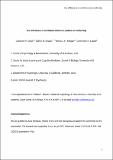Files in this item
Sex differences in confidence influence patterns of conformity
Item metadata
| dc.contributor.author | Cross, Catharine P. | |
| dc.contributor.author | Brown, Gillian R. | |
| dc.contributor.author | Morgan, Thomas J. H. | |
| dc.contributor.author | Laland, Kevin N. | |
| dc.date.accessioned | 2017-11-16T09:30:08Z | |
| dc.date.available | 2017-11-16T09:30:08Z | |
| dc.date.issued | 2017-11 | |
| dc.identifier | 246781015 | |
| dc.identifier | 3e5160b9-99bc-4939-a32f-7714bdd8704f | |
| dc.identifier | 85000450759 | |
| dc.identifier | 000412284500001 | |
| dc.identifier.citation | Cross , C P , Brown , G R , Morgan , T J H & Laland , K N 2017 , ' Sex differences in confidence influence patterns of conformity ' , British Journal of Psychology , vol. 108 , no. 4 , pp. 655-667 . https://doi.org/10.1111/bjop.12232 | en |
| dc.identifier.issn | 0007-1269 | |
| dc.identifier.other | ORCID: /0000-0002-0675-0780/work/60195734 | |
| dc.identifier.other | ORCID: /0000-0001-8110-8408/work/60427417 | |
| dc.identifier.other | ORCID: /0000-0002-2457-0900/work/60630327 | |
| dc.identifier.uri | https://hdl.handle.net/10023/12109 | |
| dc.description | The research was supported in part by an ERC Advanced Grant (EVOCULTURE, Ref.232823) awarded to KNL. | en |
| dc.description.abstract | Lack of confidence in one's own ability can increase the likelihood of relying on social information. Sex differences in confidence have been extensively investigated in cognitive tasks, but implications for conformity have not been directly tested. Here, we tested the hypothesis that, in a task that shows sex differences in confidence, an indirect effect of sex on social information use will also be evident. Participants (N = 168) were administered a mental rotation (MR) task or a letter transformation (LT) task. After providing an answer, participants reported their confidence before seeing the responses of demonstrators and being allowed to change their initial answer. In the MR, but not the LT, task, women showed lower levels of confidence than men, and confidence mediated an indirect effect of sex on the likelihood of switching answers. These results provide novel, experimental evidence that confidence is a general explanatory mechanism underpinning susceptibility to social influences. Our results have implications for the interpretation of the wider literature on sex differences in conformity. | |
| dc.format.extent | 580871 | |
| dc.language.iso | eng | |
| dc.relation.ispartof | British Journal of Psychology | en |
| dc.subject | Gender | en |
| dc.subject | Social learning | en |
| dc.subject | Mental rotation | en |
| dc.subject | Letter transformation | en |
| dc.subject | Gender stereotype | en |
| dc.subject | Stereotype threat | en |
| dc.subject | BF Psychology | en |
| dc.subject | DAS | en |
| dc.subject | BDC | en |
| dc.subject.lcc | BF | en |
| dc.title | Sex differences in confidence influence patterns of conformity | en |
| dc.type | Journal article | en |
| dc.contributor.sponsor | European Research Council | en |
| dc.contributor.institution | University of St Andrews. School of Psychology and Neuroscience | en |
| dc.contributor.institution | University of St Andrews. Centre for Social Learning & Cognitive Evolution | en |
| dc.contributor.institution | University of St Andrews. School of Biology | en |
| dc.contributor.institution | University of St Andrews. Scottish Oceans Institute | en |
| dc.contributor.institution | University of St Andrews. Institute of Behavioural and Neural Sciences | en |
| dc.contributor.institution | University of St Andrews. Centre for Biological Diversity | en |
| dc.identifier.doi | https://doi.org/10.1111/bjop.12232 | |
| dc.description.status | Peer reviewed | en |
| dc.date.embargoedUntil | 2017-11-11 | |
| dc.identifier.grantnumber | en |
This item appears in the following Collection(s)
Items in the St Andrews Research Repository are protected by copyright, with all rights reserved, unless otherwise indicated.

